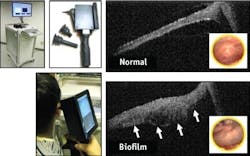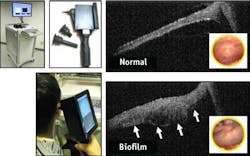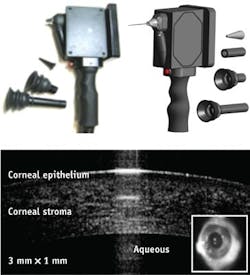Researchers develop handheld OCT device for primary care physician use
Engineers from the University of Illinois at Urbana-Champaign (UIUC) have developed a handheld optical coherence tomography (OCT) scanner to enable primary care physicians, for the first time, to see inside the human body in real time to diagnose illnesses. Now, primary care physicians will be able to image bacterial colonies in the middle ear in 3D or monitor the thickness and health of patients' retinas, for example.
To monitor chronic conditions such as ear infections, primary care physicians currently rely on instruments that are essentially magnifying glasses, says UIUC physician and biomedical engineer Stephen Boppart. The new handheld imaging device would give doctors a way to quantitatively monitor these conditions, and possibly make more efficient and accurate referrals to specialists.
The scanners include a near-infrared (NIR) light source and OCT system, a video camera to relay real-time images of surface features and scan locations, and a microelectromechanical systems (MEMS)-based scanner to direct the light. Near-infrared wavelengths of light penetrate deeper into human tissues than other wavelengths more readily absorbed by the body. By measuring the time it takes the light to bounce back from tissue microstructure, computer algorithms build a picture of the structure of tissue under examination.
Diabetic patients in particular may benefit from the device. About 40 to 45 percent of diabetics develop leaky blood vessels in their retinas (retinopathy), which can lead to thickening of the retina, blurry vision, and eventually blindness. The handheld OCT device would allow doctors to monitor the health of the retina, potentially catching retinopathy in its early stages. In some cases, changes in the eye could help doctors diagnose diabetes, Boppart says.
Boppart and his research team are hopeful that falling production costs combined with smaller, more compact designs will enable more physicians to take advantage of the scanners, and become a common point-of-care tool. Eventually, they would like to see the imagers at work in developing countries as well. He and an international team of collaborators recently received a $5 million National Institutes of Health Bioengineering Research Partnership grant to further refine the device.
The research team will present their findings at Frontiers in Optics (FiO) 2012, taking place October 14â18 in Rochester, NY, on Tuesday, October 16, at 11:15 a.m. EDT (Presentation FTu2C.3, âPrimary Care Imaging using Optical Coherence Tomography for Advanced Point-of-Care Diagnosticsâ).
-----
Follow us on Twitter, 'like' us on Facebook, and join our group on LinkedIn
Laser Focus World has gone mobile: Get all of the mobile-friendly options here.
Subscribe now to BioOptics World magazine; it's free!


